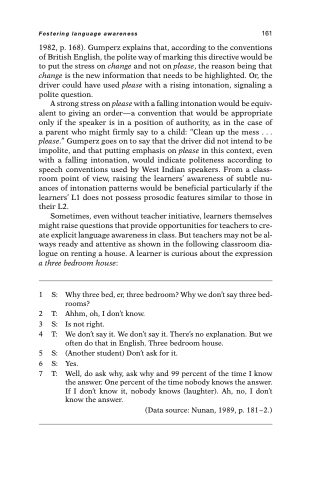Page 173 - Beyond Methods
P. 173
Fostering language awareness 161
1982, p. 168). Gumperz explains that, according to the conventions of British English, the polite way of marking this directive would be to put the stress on change and not on please, the reason being that change is the new information that needs to be highlighted. Or, the driver could have used please with a rising intonation, signaling a polite question.
A strong stress on please with a falling intonation would be equiv- alent to giving an order—a convention that would be appropriate only if the speaker is in a position of authority, as in the case of a parent who might firmly say to a child: “Clean up the mess . . . please.” Gumperz goes on to say that the driver did not intend to be impolite, and that putting emphasis on please in this context, even with a falling intonation, would indicate politeness according to speech conventions used by West Indian speakers. From a class- room point of view, raising the learners’ awareness of subtle nu- ances of intonation patterns would be beneficial particularly if the learners’ L1 does not possess prosodic features similar to those in their L2.
Sometimes, even without teacher initiative, learners themselves might raise questions that provide opportunities for teachers to cre- ate explicit language awareness in class. But teachers may not be al- ways ready and attentive as shown in the following classroom dia- logue on renting a house. A learner is curious about the expression a three bedroom house:
1 S:
2 T:
3 S:
4 T:
5 S:
6 S:
7 T:
Why three bed, er, three bedroom? Why we don’t say three bed- rooms?
Ahhm, oh, I don’t know. Is not right.
We don’t say it. We don’t say it. There’s no explanation. But we often do that in English. Three bedroom house.
(Another student) Don’t ask for it.
Yes.
Well, do ask why, ask why and 99 percent of the time I know the answer. One percent of the time nobody knows the answer. If I don’t know it, nobody knows (laughter). Ah, no, I don’t know the answer.
(Data source: Nunan, 1989, p. 181–2.)


